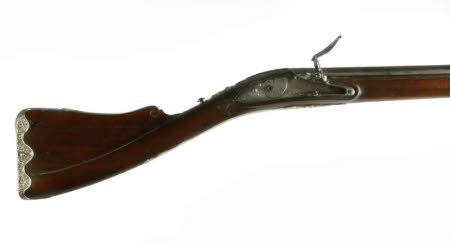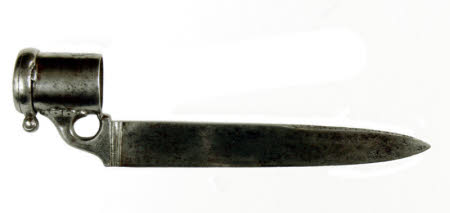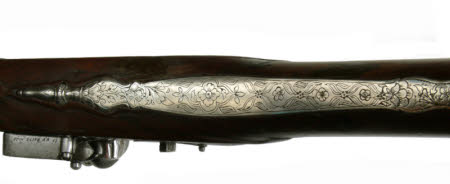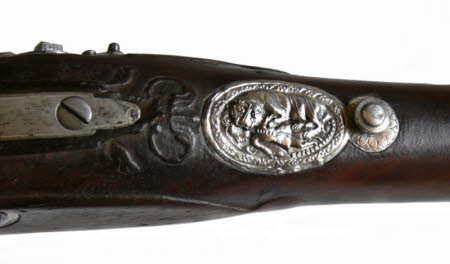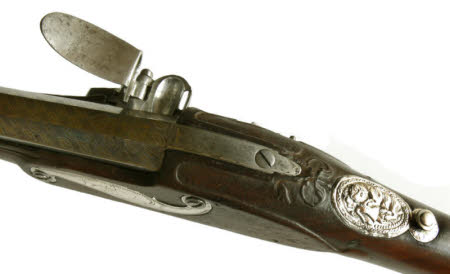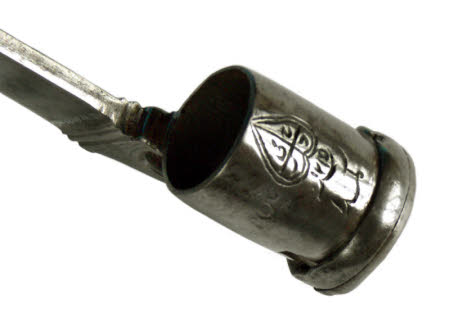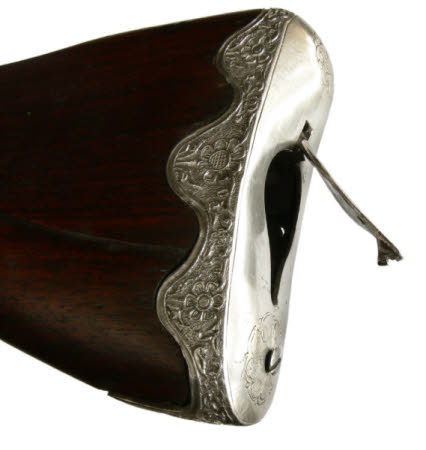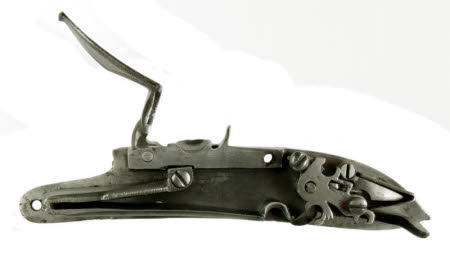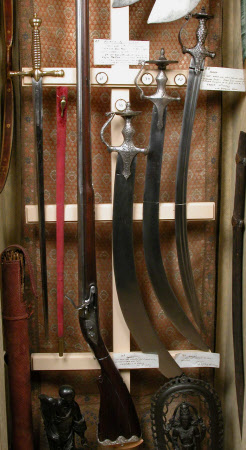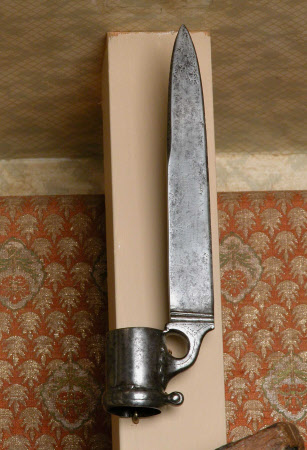Flintlock gun
Category
Arms and armour
Date
1786 - 1787
Materials
Wood, steel, iron, silver, lacquer and gold
Measurements
1460 mm (L)
Place of origin
Mysuru (Mysore)
Order this imageCollection
Powis Castle and Garden, Powys
NT 1180569
Summary
Firearm. 12 bore flintlock sporting gun from Srirangapatna, Mysuru (formerly known as Seringapatam, Mysore). Made in 1215 (by the Mauludi calendar) or 1786-7 CE. The long tapering iron barrel is octagonal at the breech and round at the muzzle. The barrel has a silver and gold inlay; the breech is decorated with gold and silver bubri (tiger stripe motif). The silver mounts are cast, chased and engraved with floral motifs. The full stock is wooden, the butt deeply curved and carved behind the barrel tang and around the rear ramrod pipe. Engraved and chiselled silver mounts comprising; buttplate (with concealed and sprung trap for a socket bayonet), false trigger plate with decorative finial, scroll form side-plate, fore-end cap and 5 ramrod pipes (1 missing). No trigger or trigger guard is fitted, the mechanism being fired by pressing a small silver button fitted at the top of the wrist, behind the barrel tang. This trigger release mechanism is highly unusual. The short iron socket bayonet on display would normally be concealed in the butt behind a sprung trap. There is also a bayonet lug and a brass blade foresight at muzzle. There is a raised pan formed with rainwater vents and with corresponding recess cut in pan cover to form a water-proof fit; a foot of frizzen with anti-friction roller, retained to the stock by 2 sidenails; and an iron ramrod with decorative tip, the rear end threaded for a cleaning tool. The cock is missing. The gun bears inscriptions which name Haydar and ‘the Victorious Lion of God’, referring to Ali, cousin to the prophet Muhammad, who was nicknamed ‘Haydar’, which means ‘lion’ in Arabic, but also to Tipu’s father, Hyder Ali. An image of a man being mauled by a tiger is stamped on an escutcheon [Archer et al, p. 64]. The gun incorporates many of the latest designs found on flintlocks of the period. It was manufactured at Srirangapatna, Mysuru (formerly known as Seringapatam, Mysore), the site of the palace and court of Tipu Sultan (1750-99), who reigned from 1782-99. The gun is dated to 1215 of the Mauludi era, a calendar adopted by Tipu, which counted the years from 572 AD, understood by Tipu to be the year of the birth of the Prophet Muhammad.
Full description
Tipu was a powerful ruler whose reign was characterised by military conflict and reform. During his 17-year reign, Tipu introduced direct revenue collection, changes to land ownership, investment in agriculture and industrialisation, and social reforms. He also supported the establishment of factories and trading companies beyond Mysuru and the immigration of skilled foreign workers in order to develop local capability to produce modern firearms [Satyanarayana, p. 2245-7]. Tipu associated himself with a tiger motif, a powerful emblem in pre-colonial India. Many items associated with Tipu bear representations of tigers and tiger stripes, including arms, coins, book bindings, and eight tiger-head finials from his throne [Brittlebank, p. 258-9]. One finial was acquired by Edward and Henrietta Clive after the sack of Srirangapatna in 1799 [NT 1180713]. Research Note on Provenance Tipu Sultan spent much of his reign engaged in the defence of Mysuru against encroachment by the British East India Company. In 1798, a renewed British campaign provoked the Fourth Anglo-Mysore War. On 4th May 1799, during the Siege of Srirangapatna, Tipu was killed. In the immediate aftermath, the British army looted the town. According to Colonel Arthur Wellesley, later the Duke of Wellington, ‘Scarcely a house in the town was left unplundered, and I understand that in camp jewels of the greatest value, bars of gold etc etc have been offered for sale in the bazaars of the army by our soldiers, sepoys and followers. I came in to take command of the army on the morning of the 5th and with the greatest exertion, by hanging, flogging etc etc in the course of that day I restored order…’ [Dalrymple, p. 351]. The resumption of control by the higher ranks of the army enabled the work of the prize committee to begin. Prize committees were responsible for ‘collecting, inventorying and disposing of booty seized from the enemy and for … seeking to establish combatants’ entitlement to prize' [Finn, p.17]. They were intended to prevent the kind of undisciplined plunder which Wellesley reported in the aftermath of Tipu’s defeat at Srirangapatna. More than 1,000 commissioned officers took their allotted share in the captured property, which they kept, exchanged or sold to others. High value, or high-profile items, were excluded from the prize committee’s remit, and given to senior civil and military personnel, as well as the British royal family. Not all articles were genuine: tenuous or spurious attributions to Tipu Sultan have been identified in objects which were brought to Britain. Recent work on a sword at the Wallace Collection [OA1402] has shown that an inscription on the blade suggesting personal ownership by Tipu was added after his death in 1799. A letter to Edward Clive (1754-1839), then Governor of Madras (1798-1803), may refer to this gun, shedding light on how it reached Powis Castle. Allan Grant, a captain in one of the armies which besieged Srirangapatna, wrote on 30th November 1799: ‘Understanding from Genl. Floyd that Swords or Firelocks made in the Arsenal of this place & found in the Palace of the late Tippoo Sultaun, are consider'd curious, & much sought after at Madras. I have taken the liberty of sending to your Lordship by Lieutt. Sydenham a small assortment of these Articles, which appear to me of equal workmanship with any that have been found here: particularly the Firelock with a Concealed Bayonet which I understand from the Person who made it was a favourite gun of the late Sultaun's. The Curious Gun was a present to the Sultaun from Constantinople".’ It is unclear whether the descriptions of the ‘Firelock’ and the ‘Curious Gun’ refer to the same item. [1] [1] British Library, IOR/L/MIL/5/159: Prize and Batta Rolls: Seringapatam 1799 (1800)
Provenance
Accepted by HM Treasury on 21st March, 1963 in lieu of tax and conveyed to National Trust ownership on 29th November 1963.
Marks and inscriptions
Lockplate: Stamped 'Patan' beneath the pan within a hexagonal frame. 'Patan' and 'KMSDA’ or ‘KMSDR’ (in Persian script) engraved beneath it. ‘Talismanic square, a kind of dynastic seal’, composed of the four Persian letters of the name Haydar [Transcription and commentary from Treasures from India, p. 64] Barrel tang: ‘313’ in gold script and ‘4’ below this. Between barrel tang and trigger button: A large oval escutcheon with an image of a man being mauled by a tiger. The face of the tiger is a caligramme of mirrored calligraphy, which is translated as “The Victorious Lion of God”. [Transcription and translation from Treasures from India, p. 64] Bayonet socket ring: Stamped with the square of letters making up the word Haydar, the date 1215 (1786/7 CE), the maker, ‘KMSDA’ or ‘KMSDR’, and the place of manufacture, ‘Patan’.
References
2019 Dalrymple: W Dalrymple, The Anarchy: The Relentless Rise of the East India Company, Bloomsbury 2019 2018 Finn: Margot Finn, ‘Material Turns in British History I: Loot’, Transactions of the Royal Historical Society, Vol. 28, December 2018 2004 Satyanarayana: A Satyanarayana ‘Review: The Mysore Sultans. State and Diplomacy under Tipu Sultan: Documents and Essays by Irfan Habib’ Economic and Political Weekly 39 24 (2004) 1995 Brittlebank: K Brittlebank, ‘Sakti and Barakat: The Power of Tipu’s Tiger. An Examination of the Tiger Emblem of Tipu Sultan of Mysore’, Modern Asian Studies 29 2 (1995) Archer, Rowell and Skelton 1987 Mildred Archer, Christopher Rowell, and Robert Skelton, Treasures from India: The Clive Collection at Powis Castle, London, 1987 Wigington, 1992: Robin Wigington, The Firearms of Tipu Sultan 1783-1799
